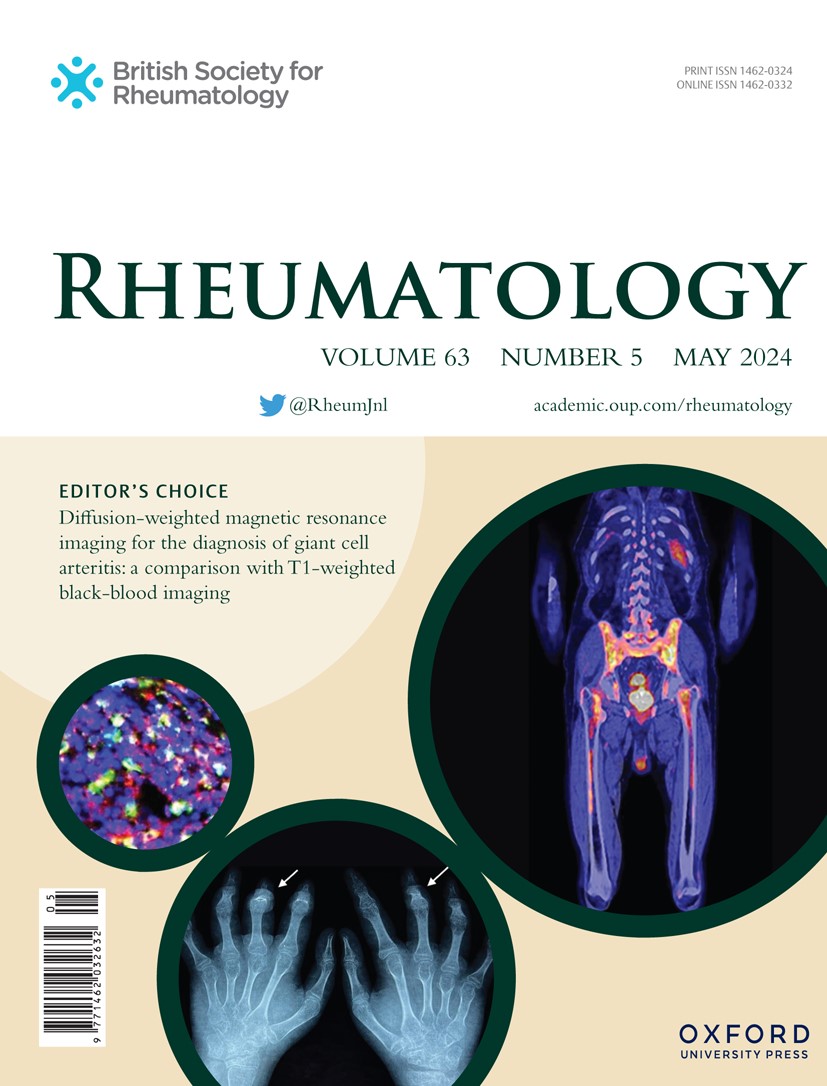Ten-year cardiovascular risk changes and major adverse events in gout patients
IF 4.4
2区 医学
Q1 RHEUMATOLOGY
引用次数: 0
Abstract
Objective The long-term interaction between cardiovascular (CV) risk profiles and gout may influence the risk of cardiovascular events. However, the impact of gout and long-term changes in CV risk profile on CV events is unclear. Methods This was a nationwide cohort study based on the Korean National Health Insurance claims database and the National Health Screening Program. Patients aged 20–90 years newly diagnosed with gout after January 2012 and age- and sex-matched controls without gout were included. After adjusting for CV risk profiles measured 10 years before gout diagnosis and their long-term changes, the relative risks of incident CV events (myocardial infarction, cerebral infarction and cerebral haemorrhage) and all-cause death in the gout patients were assessed. Results In total, 113 853 patients with gout and 1 138 530 matched controls were studied. Multivariable analysis showed that gout was associated with increased risks for myocardial infarction (hazard ratio [HR]: 1.39, P < 0.001), cerebral infarction (HR: 1.36, P < 0.001), cerebral haemorrhage (HR: 1.50, P < 0.001), and all-cause death (HR: 1.07, P = 0.004). In addition, significant interactions were observed for myocardial infarction (Grade 1 aggravation over 10 years of diastolic blood pressure [DBP], P = 0.042), cerebral infarction (Grade 2 aggravation over 10 years of DBP, P = 0.037) and cerebral haemorrhage (Grade 2 aggravation over 10 years of total cholesterol, P = 0.057). Conclusions Gout patients had a high risk of incident CV events even after adjusting for CV risk profiles and their long-term changes. These long-term changes additively increase the risk of CV events in gout patients.痛风患者10年心血管风险变化及主要不良事件
目的心血管(CV)风险与痛风之间的长期相互作用可能影响心血管事件的发生。然而,痛风和心血管风险状况的长期变化对心血管事件的影响尚不清楚。方法这是一项基于韩国国民健康保险索赔数据库和国家健康筛查计划的全国性队列研究。2012年1月后新诊断为痛风的20-90岁患者和无痛风的年龄和性别匹配的对照组纳入研究。在调整痛风诊断前10年测量的CV风险概况及其长期变化后,评估痛风患者发生CV事件(心肌梗死、脑梗死和脑出血)和全因死亡的相对风险。结果共纳入113 853例痛风患者和1 138 530例对照组。多变量分析显示,痛风与心肌梗死(风险比[HR]: 1.39, P < 0.001)、脑梗死(风险比[HR]: 1.36, P < 0.001)、脑出血(风险比:1.50,P < 0.001)和全因死亡(风险比:1.07,P = 0.004)的风险增加相关。此外,在心肌梗死(舒张压加重1级超过10年,P = 0.042)、脑梗死(舒张压加重2级超过10年,P = 0.037)和脑出血(总胆固醇加重2级超过10年,P = 0.057)之间观察到显著的相互作用。结论:即使在调整了CV风险特征及其长期变化后,痛风患者仍有较高的CV事件发生风险。这些长期变化增加了痛风患者心血管事件的风险。
本文章由计算机程序翻译,如有差异,请以英文原文为准。
求助全文
约1分钟内获得全文
求助全文
来源期刊

Rheumatology
医学-风湿病学
CiteScore
9.40
自引率
7.30%
发文量
1091
审稿时长
2 months
期刊介绍:
Rheumatology strives to support research and discovery by publishing the highest quality original scientific papers with a focus on basic, clinical and translational research. The journal’s subject areas cover a wide range of paediatric and adult rheumatological conditions from an international perspective. It is an official journal of the British Society for Rheumatology, published by Oxford University Press.
Rheumatology publishes original articles, reviews, editorials, guidelines, concise reports, meta-analyses, original case reports, clinical vignettes, letters and matters arising from published material. The journal takes pride in serving the global rheumatology community, with a focus on high societal impact in the form of podcasts, videos and extended social media presence, and utilizing metrics such as Altmetric. Keep up to date by following the journal on Twitter @RheumJnl.
 求助内容:
求助内容: 应助结果提醒方式:
应助结果提醒方式:


